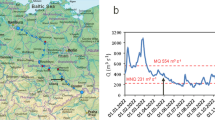Abstract
The population dynamics of three coexisting Daphnia species are described by means of a discrete event simulation model. The model is formulated in the algorithmic language SIMULA which allows very convenient object-oriented programming. Different compartments of a lake are simulated at different levels of integration, each represented by a PROCESS CLASS in SIMULA: The properties of the lake are deposited in a set of meteorological data which were measured in the field. Fish are simulated as a population with properties which are derived from field observations and Daphnia are represented as individuals. The model shows that hypotheses about the stabilizing mechanisms (seasonal change of environmental conditions, vertical migration of Daphnia, size selective and abundance dependent feeding of planktivorous fish) of the coexistence of the Daphnia species are sufficient to explain the stable coexistence observed.
Zusammenfassung
Die Koexistenz dreier Daphnienarten wird mit Hilfe eines objektorientierten Simulationsprogrammes beschrieben. Als Beschreibungssprache dient SIMULA, das eine sehr einfache Realisierung von parallelen Prozessen und diskreten Ereignissen ermöglicht. Die verschiedenen Kompartimente eines Sees werden auf verschiedenen Integrationsniveaus simuliert, die jeweils durch eine PROCESS CLASS in SIMULA repräsentiert werden: Der See mit seinen physikalischen und chemischen Eigenschaften wird als ein Datensatz tatsächlich im Freiland gemessener Größen realisiert. Fische werden durch eine Population dargestellt, deren Eigenschaften aus Freilandbeobachtungen bestimmt wurden. Daphnien werden als Individuen simuliert. Das Modell zeigt, daß Hypothesen über die Stabilisierungsmechanismen der Koexistenz der Daphnien (jahreszeitlicher Wechsel der Umweltbedingungen, Vertikalwanderung der Daphnien, großen- und abundanzabhängiges Fressen planktivorer Fische) ausreichen, um eine stabile Koexistenz zu ermöglichen.
Access this chapter
Tax calculation will be finalised at checkout
Purchases are for personal use only
Preview
Unable to display preview. Download preview PDF.
Similar content being viewed by others
References
DeMott, W.R. (1983): Seasonal succession in a natural Daphnia assemblage. Ecol. monogr. 53:321–340
DODSON, S.I. (1974): Zooplankton competition and predation: an experimental test of the size-efficiency hypothesis. Ecology 55: 605–613
GLIWICZ, Z.M., GHILAROV, A. & PIJANOWSKA J. (1981): Food and predaation as major factors limiting two natural populations of Daphnia cucullata Sars. Hydrobiologia 80:205–218
GREEN C.H. (1983): Selective predation in freshwater Zooplankton communities. Int. Rev. ges. Hydrobiol. 68: 297–315
HALL D.J. (1964): An experimental approach to the dynamics of natural populations of Daphnia galeata mendotae. Ecology 45:94–112
HARDING. (1960): The competitive exclusion principle. Science 131:1292–1297
HUTCHINSON G.E. (1959): Homage to Santa Rosalia or why are there so many kinds of animals? Am er. Nat. 93:145–159
HUTCHINSON G.E. (1961): The paradox of the plankton. Amer. Nat. 95: 137–145
JACOBS J. (1977a): Coexistence of similar Zooplankton species by differential adaptation to reproduction and escape, in an environment with fluctuating food and enemy densities. I. A model. Oecologia (Berl.) 29: 233–247
JACOBS J. (1977b): Coexistence of similar Zooplankton species by differential adaptation to reproduction and escape, in an environment with fluctuating food and enemy densities. H. Field data analysis. Oecologia (Berl.) 30: 313–329
JACOBS J. (1985): Konkurrenz und Einnischung - Hat Konkurrenz um Ressourcen eine evolutionsbiologische Bedeutung für die Artenmannigfaltigkeit der Tiere? Z. zool. Syst. Evolut.-forsch. 23: 243–258
LYNCH M. (1977): Zooplankton competition and plankton community structure. Limnol. Oceanogr. 22: 775–777
NORTHCOTE T.G. (1988): Fish in the structure and function of freshwater ecosystems: A “top-down” view. Can. J. Fish. Aqua. Sci. 45: 361–379
SEITZ A. (1980a): The coexistence of three species of Daphnia in the Klostersee: I. Field studies on the dynamics of reproduction. Oecologia (Berl.) 45:117–130
SEITZ A (1980b): The coexistence of three species of Daphnia in the Klostersee: II. The stabilizing effect of selective mortality and conclusions for the stability of the system. Oecologia (Berl.) 47: 333–339
SEITZ A (1984): Are there allelopathic interactions in Zooplankton? Laboratory experiments with Daphnia. Oecologia (Berl.) 62: 94–96
TILLMANN U. & LAMPERT W. (1984): Competitive ability of differently sized Daphnia species: An experimental test. J. Freshwater Ecol. 2: 311–323
ZARET T.M. (1980): Predation and freshwater communities. Yale University Press, New Haven, London. 187 p.
Author information
Authors and Affiliations
Editor information
Editors and Affiliations
Rights and permissions
Copyright information
© 1991 Springer-Verlag Berlin Heidelberg
About this paper
Cite this paper
Seitz, A. (1991). The Coexistence of Three Species of Daphnia in the Klostersee: iii. The Simulation Model Coda. In: Möller, D.P.F., Richter, O. (eds) Analyse dynamischer Systeme in Medizin, Biologie und Ökologie. Informatik-Fachberichte, vol 275. Springer, Berlin, Heidelberg. https://doi.org/10.1007/978-3-642-77020-3_23
Download citation
DOI: https://doi.org/10.1007/978-3-642-77020-3_23
Publisher Name: Springer, Berlin, Heidelberg
Print ISBN: 978-3-540-54669-6
Online ISBN: 978-3-642-77020-3
eBook Packages: Springer Book Archive




